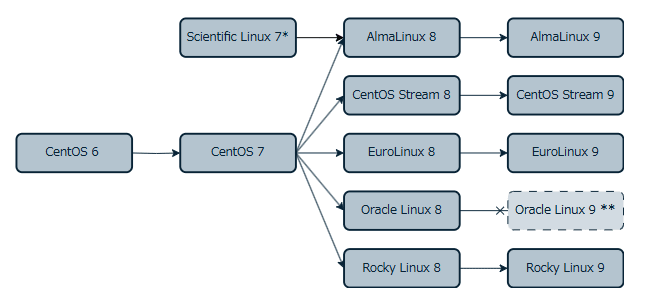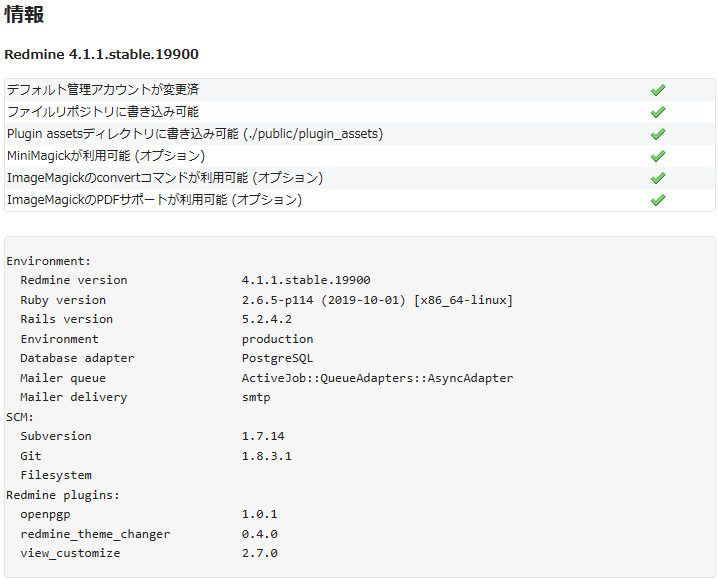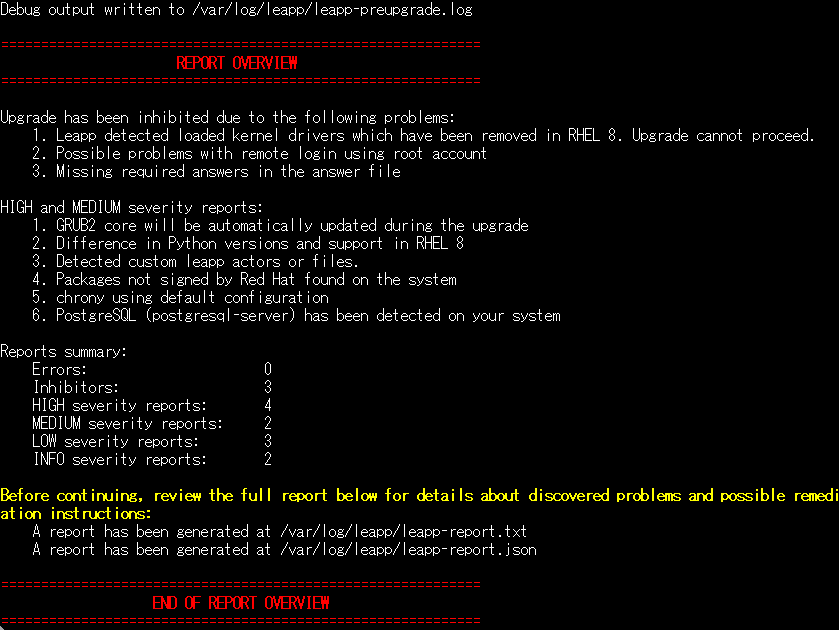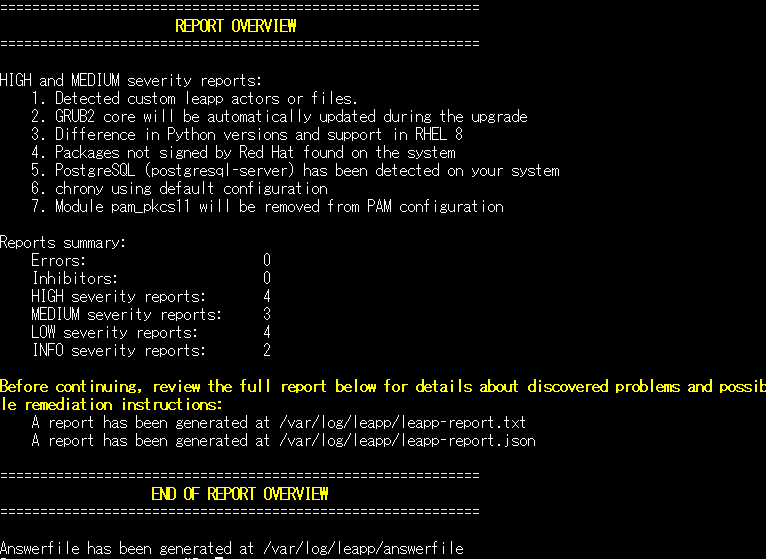Elevateを使用してRedmineサーバをCentOS7からRockyLinuxにアップデートしてみた(前編)
はじめに
2024年6月30日でCentOSがサポート終了になりましたが、CentOSを使っているサーバを更改しなきゃだけど、まだできていない、という方多いのではないでしょうか。すでにyumリポジトリも閉じていてアップデート等一切できない状態になっていて、さすがにこれはまずいな、という状況になっています。
仮想サーバで運用しているものは、一般には後継OSのVMを立ち上げてアプリケーションを再インストールし、必要なデータ移行を行って切り替えるのが一般的かとおもいます。
一方、AlmaLinuxにより、ELevateというツールが公開されているので、これを使ってCentOS7からAlmaLinux8等にアップデートする、という方法があります。しかし、OSをアップデートしてもアプリケーションがどうなるかとか、やはり心配ですよね。
そこで、すでに運用しているRedmineサーバでELevateを使用してOSをアップデートしてみるとどうなるか、やってみました。
なお、このツールはCentOSからAlmaLinuxにアップデートするだけでなく、そのほかのメジャーなディストリビューションへの移行にも対応しています。
私はRockyLinuxにアップデートすることにしました。自分のディストリビューション以外への移行にも対応するなんて、AlmaLinuxの懐の深さに感謝いたします😭

(前提条件)rootアカウントでログインできていること
以下、プロンプトの#はrootアカウントです。
更改前の情報
OSはCentOS7.8、カーネルのバージョンは以下のとおりです。
カーネルについては、この後の手順内でyum updateするので実際にはCentOS7.9、3.10.0-1160.119.1.el7.x86_64からのアップデートになります。
# cat /etc/redhat-release
CentOS Linux release 7.8.2003 (Core)
# uname -r
3.10.0-1127.18.2.el7.x86_64
以下に示すとおり、少々Redmineが古いバージョンですが、Redmineのバージョンアップは今回の記事のスコープ外とします。

ELevateによるOSアップデートの概要
詳細は 公式サイト を見ていただければとおもいますが、ざっくりいうと以下の流れとなります
公式サイトにも書かれていますが、事前にバックアップやスナップショットを取得するなどしておきましょう。
1.事前準備
- CentOSのリポジトリをAlmaLinuxが提供するURLに変更し、OSをアップデートする
- leappをインストール
2.環境の事前チェックと問題の解消
- leapp preupgradeの実行
- 発見されたエラー/ワーニングの対処方法を検討
- エラー/ワーニングを解消する、または対応方法をアンサーファイルに書きこむ
- 再度leapp preupgradeを実行して解消されたか確認する
3.アップグレードを実行
以下、実際にこの環境でアップグレードを実行していきます。
事前準備
AlmaLinuxによるquick-start-guideを見て、コマンドを実行していきます。
# sudo curl -o /etc/yum.repos.d/CentOS-Base.repo https://el7.repo.almalinux.org/centos/CentOS-Base.repo
# sudo yum update -y
# sudo reboot
(出力結果は割愛)
再起動後、再度Terminalを起動して、作業を継続します。今回はAlmaLinuxではなくRockyLinuxにアップグレードするのでleapp-data-rockyをインストールします。
# uname -r
3.10.0-1160.119.1.el7.x86_64
# cat /etc/redhat-release
CentOS Linux release 7.9.2009 (Core)
# sudo yum install -y http://repo.almalinux.org/elevate/elevate-release-latest-el$(rpm --eval %rhel).noarch.rpm
(出力結果は割愛)
# sudo yum install -y leapp-upgrade leapp-data-rocky
(出力結果は割愛)
環境の事前チェックと問題の解消
# sudo leapp preupgrade
大量に表示される途中表示は割愛しますが、最後に以下のようなレポートが表示されます。表示されているとおり、アップグレードの詳細ログは/var/log/leapp/leapp-preupgrade.logにも出力されています。

実際に表示される内容は、それぞれの実行環境によって異なると思いますが、ここでは私の環境で表示されたエラーについて、一つ一つ対処をしていきます。
問題点の確認と対処詳細
1. Leapp detected loaded kernel drivers which have been removed in RHEL 8. Upgrade cannot proceed
Risk Factor: high (inhibitor)
Title: Leapp detected loaded kernel drivers which have been removed in RHEL 8.
Upgrade cannot proceed.
Summary: Support for the following RHEL 7 device drivers has been removed in RHEL 8:
- pata_acpi
RHEL8で削除されたカーネルドライバを検知した、とのことです。レポートの詳細を確認すると、pata_acpiというモジュールであることがわかります。
このドライバは不要なので削除します。
# sudo rmmod pata_acpi
2. Possible problems with remote login using root account
Risk Factor: high (inhibitor)
Title: Possible problems with remote login using root account
Summary: OpenSSH configuration file does not explicitly state the option
PermitRootLogin in sshd_config file, which will default in RHEL8 to
"prohibit-password".
Remediation: [hint] If you depend on remote root logins using passwords,
consider setting up a different user for remote administration or adding
"PermitRootLogin yes" to sshd_config.
If this change is ok for you, add explicit "PermitRootLogin prohibit-password"
to your sshd_config to ignore this inhibitor
ルートアカウントでのリモートログインが許可されている(RHEL8ではデフォルトではprohibit-passworになっている)とのことです。
私の環境ではrootで最初からログインすることはなく、一般ユーザからsuする使い方をしているので、明示的にprohibit-passwordに設定します。
(#PermitRootLogin yesという記述があるのでその下に以下を追加します)
PermitRootLogin prohibit-password
3. Missing required answers in the answer file
Risk Factor: high (inhibitor)
Title: Missing required answers in the answer file
Summary: One or more sections in answerfile are missing user choices:
remove_pam_pkcs11_module_check.confirm
For more information consult https://red.ht/leapp-dialogs.
Related links:
- Leapp upgrade fail with error
"Inhibitor: Missing required answers in the answer file": https://access.redhat.com/solutions/7035321
Remediation: [hint] Please register user choices with leapp answer cli command
or by manually editing the answerfile.
[command] leapp answer --section remove_pam_pkcs11_module_check.confirm=True
出力のとおり、アンサーファイルに必要な回答がなされていない、ということです。出力で指示されているとおり、leapp answer --section remove_pam_pkcs11_module_check.confirm=Trueを実行するか、手動でアンサーファイルを編集します
[remove_pam_pkcs11_module_check]
# Title: None
# Reason: Confirmation
# =================== remove_pam_pkcs11_module_check.confirm ==================
# Label: Disable pam_pkcs11 module in PAM configuration? If no, the upgrade process will be interrupted.
# Description: PAM module pam_pkcs11 is no longer available in RHEL-8 since it was replaced by SSSD.
# Reason: Leaving this module in PAM configuration may lock out the system.
# Type: bool
# Default: None
# Available choices: True/False
# Unanswered question. Uncomment the following line with your answer
confirm = True
上記が対応必須な問題点であり、これでpreupgradeをもう一度実行すればinhibited problemsのところが解消され、レポートが黄色表示になりました。

その他のリスクの確認
1. Difference in Python versions and support in RHEL 8
Risk Factor: high
Title: Difference in Python versions and support in RHEL 8
Summary: In RHEL 8, there is no 'python' command.Python 3
(backward incompatible) is the primary Python version
and Python 2 is available with limited support and limited set of packages.
If you no longer require Python 2 packages following the upgrade,
please remove them. Read more here: https://red.ht/rhel-8-python
Related links:
- Difference in Python versions and support in RHEL 8:
https://red.ht/rhel-8-python
Remediation: [hint] Please run "alternatives --set python /usr/bin/python3" after upgrade
RHEL8にはPythonコマンドはなく、Python3になっている。Python2は限定的に利用可能なだけ。Python2が必要ないのであればアップグレードを検討するべき。
→Python2はCentOSではシステムパッケージに依存している可能性があるため、拙速に削除するのは怖い。ヒントとしても表示されているとおり、アップグレード後に対応することとする。
2. GRUB2 core will be automatically updated during the upgrade
Risk Factor: high
Title: GRUB2 core will be automatically updated during the upgrade
Summary: On legacy (BIOS) systems, GRUB2 core (located in the gap between the MBR
and the first partition) cannot be updated during the rpm transaction
and Leapp has to initiate the update running "grub2-install" after the transaction.
No action is needed before the upgrade. After the upgrade,
it is recommended to check the GRUB configuration.
GRUB2(ブートローダ)はOSアップグレードの際に自動的にアップデートされます、とのこと。アップグレード前には特にアクション不要。アップデート後にGRUB2設定を確認する。
3. Detected custom leapp actors or files
Risk Factor: high
Title: Detected custom leapp actors or files.
Summary: We have detected installed custom actors or files on the system.
These can be provided e.g. by third party vendors, Red Hat consultants,
or can be created by users to customize the upgrade (e.g. to migrate custom applications).
This is allowed and appreciated. However Red Hat is not responsible for any issues caused by these custom leapp actors.
Note that upgrade tooling is under agile development which could require more frequent update of custom actors.
The list of custom leapp actors and files:
- /usr/share/leapp-repository/repositories/system_upgrade/common/files/rpm-gpg/8/RPM-GPG-KEY-Rocky-8
Related links:
- Customizing your Red Hat Enterprise Linux in-place upgrade: https://red.ht/customize-rhel-upgrade
Remediation: [hint] In case of any issues connected to custom or third party actors, contact vendor of such actors.
Also we suggest to ensure the installed custom leapp actors are up to date, compatible with the installed packages.
カスタムleappアクターを検出した、とのこと。RPM-GPG-KEY-Rocky-8がその対象になっているようです。
このファイルは、leappの手順どおりにGPG keyをインストールしたことによるものですので無視します。
想定されるファイルなので警告出さないでほしいところですが、とりあえずアクション不要とおもいます。
4. Packages not signed by Red Hat found on the system
Risk Factor: high
Title: Packages not signed by Red Hat found on the system
Summary: The following packages have not been signed by Red Hat and may be removed
during the upgrade process in case Red Hat-signed packages to be removed
during the upgrade depend on them:
- AwsAgent
- ansible
- certbot
- epel-release
- python-ndg_httpsclient
- python-requests-toolbelt
- python-zope-component
- python-zope-event
- python2-acme
- python2-certbot
- python2-certbot-apache
- python2-configargparse
- python2-distro
- python2-future
- python2-httplib2
- python2-jmespath
- python2-josepy
- python2-mock
- python2-parsedatetime
- python2-pyrfc3339
- python2-six
これらのファイルはRedHatが署名したものではない、アップグレードによって削除される可能性がある、とのこと。
AwsAgentはAWSのエージェントですね。私の環境では意図的にいれたものではないので特に気にしないことにします。ansibleはRedmineをインストールする際に自分でいれたもの。certbotはLet's EncryptのSSL証明書更新ツール。epel-releaseはepelのリポジトリのファイルで自分で入れたものです。pythonやpython2で始まるものは、特に意識して入れたものではなくディストリビューションにもとから入っているものですが、前の項目でもpython3がデフォルトになっており、アップグレードで削除されても別にいいかとおもいます。
ということで、アップデート後にAnsible,certbot,epel-releaseが問題ないか確認することにします。
5. PostgreSQL (postgresql-server) has been detected on your system
Risk Factor: medium
Title: PostgreSQL (postgresql-server) has been detected on your system
Summary: PostgreSQL server component will be upgraded.
Since RHEL-8 includes PostgreSQL server 10 by default, which is incompatible with 9.2 included in RHEL-7,
it is necessary to proceed with additional steps
for the complete upgrade of the PostgreSQL data.
Related links:
- Migrating to a RHEL 8 version of PostgreSQL: https://red.ht/rhel-8-migrate-postgresql-server
Remediation: [hint] Back up your data before proceeding with the upgrade and follow steps in the documentation section
"Migrating to a RHEL 8 version of PostgreSQL" after the upgrade.
PostgreSQLが検出されたとのこと。リスクファクターはMediumですが、RedmineサーバとしてはPostgreSQLが動かなくなるのは致命的なのでちゃんと対応しないといけない項目です。
移行のために必要になるとおもわれるので、きちんとDBのバックアップはとっておきましょう。(DBのバックアップ方法はRedmine.JPの記事「データのバックアップ方法」をご参照ください)
6. chrony using default configuration
Risk Factor: medium
Title: chrony using default configuration
Summary: default chrony configuration in RHEL8 uses leapsectz directive,
which cannot be used with leap smearing NTP servers,
and uses a single pool directive instead of four server directives
RHELではchronyはデフォルトでleapsectzディレクティブを使う。この場合、leap smearing NTPサーバを使うことはできない。4つのserverディレクティブの代わりに1津のpoolディレクティブを使う、とのことです。
NTPサーバの設定まわりの記述だということがわかりますね。アップデート後にchronyの設定がどうなっているか、確認することとします。
7. Module pam_pkcs11 will be removed from PAM configuration
Risk Factor: medium
Title: Module pam_pkcs11 will be removed from PAM configuration
Summary: Module pam_pkcs11 was surpassed by SSSD and therefore it was removed from RHEL-8.
Keeping it in PAM configuration may lock out the system thus it will be automatically
removed from PAM configuration before upgrading to RHEL-8.
Please switch to SSSD to recover the functionality of pam_pkcs11.
Remediation: [hint] Configure SSSD to replace pam_pkcs11
pam_pkcs11というのは、PCKS#11スマートカードを使用してユーザ名とパスワードを検証するモジュールとのことです。私の環境では使っていないので気にしませんが、使っている場合はpam_pkcs11の代わりにSSSDを使え、と書かれてますね。
事前準備まとめ
さて、ここまででleapp preupgradeで表示された問題の対処とリスクを確認できました。私の環境ではこれだけでしたが、別の環境では違う問題やリスクが表示される可能性はあります。ただ、leapp-reportはとてもわかりやすく書かれているので、読めば何を対応するべきなのかだいたいわかる、という印象でした。
また、leapp preupgradeは何回でも実行できるので、いろいろ試して結果が変わるかどうかを確かめるのもよいとおもいます。
アップグレード
sudo leapp upgradeが終わったら、再起動します。再起動は、環境にもよりますが、すこし時間がかかる場合があります。
(公式ドキュメントにも書いてあるとおりです)
アップグレードの実行
# sudo leapp upgrade
# reboot
アップグレードできたか確認
ちゃんとRocky Linuxにアップグレードできました。
$ cat /etc/redhat-release
Rocky Linux release 8.10 (Green Obsidian)
$ cat /etc/os-release
NAME="Rocky Linux"
VERSION="8.10 (Green Obsidian)"
ID="rocky"
ID_LIKE="rhel centos fedora"
VERSION_ID="8.10"
PLATFORM_ID="platform:el8"
PRETTY_NAME="Rocky Linux 8.10 (Green Obsidian)"
ANSI_COLOR="0;32"
LOGO="fedora-logo-icon"
CPE_NAME="cpe:/o:rocky:rocky:8:GA"
HOME_URL="https://rockylinux.org/"
BUG_REPORT_URL="https://bugs.rockylinux.org/"
SUPPORT_END="2029-05-31"
ROCKY_SUPPORT_PRODUCT="Rocky-Linux-8"
ROCKY_SUPPORT_PRODUCT_VERSION="8.10"
REDHAT_SUPPORT_PRODUCT="Rocky Linux"
REDHAT_SUPPORT_PRODUCT_VERSION="8.10"
$ rpm -qa | grep el7 # for 7 to 8 upgrade
leapp-0.18.0-1.el7.noarch
python2-parsedatetime-2.4-6.el7.noarch
python-zope-event-4.0.3-2.el7.noarch
python2-leapp-0.18.0-1.el7.noarch
python2-distro-1.5.0-1.el7.noarch
python2-httplib2-0.18.1-3.el7.noarch
kernel-3.10.0-1127.18.2.el7.x86_64
leapp-upgrade-el7toel8-0.21.0-2.el7.elevate.3.noarch
python2-jmespath-0.9.4-2.el7.noarch
python2-pyrfc3339-1.1-3.el7.noarch
kernel-3.10.0-1160.119.1.el7.x86_64
python2-future-0.18.2-2.el7.noarch
leapp-data-rocky-0.4-7.el7.20240827.noarch
python2-configargparse-0.11.0-2.el7.noarch
elevate-release-1.0-2.el7.noarch
アップグレード後の対応
OSとしては無事アップグレードできていることがわかりましたが、もともとpreupgradeのときに後で対応する必要がある、とチェックしておいた項目の対応を実行します。
Pythonコマンドのシンボリックリンクを変更
# which python
/usr/bin/which: no python in (/usr/local/sbin:/usr/local/bin:/usr/sbin:/usr/bin:/root/bin)
# which python2
/usr/bin/python2
# which python3
/usr/bin/python3
アップグレード前はpythonコマンドはpython2へのシンボリックリンクになっていましたが、そのシンボリックリンクはなくなっており、/usr/bin/python2と/usr/bin/python3は存在しています。leapp-report.txtで提案されていたとおり、alternativesコマンドを使用してpython3をデフォルトのpythonコマンドにします。
# alternatives --set python /usr/bin/python3
# which python
/usr/bin/python
# python --version
Python 3.6.8
GRUB2の設定を確認
以下、GRUB2の設定を確認しました。
詳細はわからないというのが実際のところですが、デュアルブートしようとしているわけでもないですし、無事RockyLinuxが起動できているのでよしとします。
確認結果詳細
#
# DO NOT EDIT THIS FILE
#
# It is automatically generated by grub2-mkconfig using templates
# from /etc/grub.d and settings from /etc/default/grub
#
### BEGIN /etc/grub.d/00_header ###
set pager=1
if [ -f ${config_directory}/grubenv ]; then
load_env -f ${config_directory}/grubenv
elif [ -s $prefix/grubenv ]; then
load_env
fi
if [ "${next_entry}" ] ; then
set default="${next_entry}"
set next_entry=
save_env next_entry
set boot_once=true
else
set default="0"
fi
if [ x"${feature_menuentry_id}" = xy ]; then
menuentry_id_option="--id"
else
menuentry_id_option=""
fi
export menuentry_id_option
if [ "${prev_saved_entry}" ]; then
set saved_entry="${prev_saved_entry}"
save_env saved_entry
set prev_saved_entry=
save_env prev_saved_entry
set boot_once=true
fi
function savedefault {
if [ -z "${boot_once}" ]; then
saved_entry="${chosen}"
save_env saved_entry
fi
}
function load_video {
if [ x$feature_all_video_module = xy ]; then
insmod all_video
else
insmod efi_gop
insmod efi_uga
insmod ieee1275_fb
insmod vbe
insmod vga
insmod video_bochs
insmod video_cirrus
fi
}
if [ x$feature_default_font_path = xy ] ; then
font=unicode
else
insmod part_msdos
insmod xfs
set root='hd0,msdos1'
if [ x$feature_platform_search_hint = xy ]; then
search --no-floppy --fs-uuid --set=root --hint='hd0,msdos1' 2f64394d-a847-4c1a-bda9-e658edc017ad
else
search --no-floppy --fs-uuid --set=root 2f64394d-a847-4c1a-bda9-e658edc017ad
fi
font="/usr/share/grub/unicode.pf2"
fi
if loadfont $font ; then
set gfxmode=auto
load_video
insmod gfxterm
fi
terminal_output gfxterm
if [ x$feature_timeout_style = xy ] ; then
set timeout_style=menu
set timeout=0
# Fallback normal timeout code in case the timeout_style feature is
# unavailable.
else
set timeout=0
fi
### END /etc/grub.d/00_header ###
### BEGIN /etc/grub.d/00_tuned ###
set tuned_params=""
set tuned_initrd=""
### END /etc/grub.d/00_tuned ###
### BEGIN /etc/grub.d/01_users ###
if [ -f ${prefix}/user.cfg ]; then
source ${prefix}/user.cfg
if [ -n "${GRUB2_PASSWORD}" ]; then
set superusers="root"
export superusers
password_pbkdf2 root ${GRUB2_PASSWORD}
fi
fi
### END /etc/grub.d/01_users ###
### BEGIN /etc/grub.d/08_fallback_counting ###
insmod increment
# Check if boot_counter exists and boot_success=0 to activate this behaviour.
if [ -n "${boot_counter}" -a "${boot_success}" = "0" ]; then
# if countdown has ended, choose to boot rollback deployment,
# i.e. default=1 on OSTree-based systems.
if [ "${boot_counter}" = "0" -o "${boot_counter}" = "-1" ]; then
set default=1
set boot_counter=-1
# otherwise decrement boot_counter
else
decrement boot_counter
fi
save_env boot_counter
fi
### END /etc/grub.d/08_fallback_counting ###
### BEGIN /etc/grub.d/10_linux ###
insmod part_msdos
insmod xfs
set root='hd0,msdos1'
if [ x$feature_platform_search_hint = xy ]; then
search --no-floppy --fs-uuid --set=root --hint='hd0,msdos1' 2f64394d-a847-4c1a-bda9-e658edc017ad
else
search --no-floppy --fs-uuid --set=root 2f64394d-a847-4c1a-bda9-e658edc017ad
fi
insmod part_msdos
insmod xfs
set boot='hd0,msdos1'
if [ x$feature_platform_search_hint = xy ]; then
search --no-floppy --fs-uuid --set=boot --hint='hd0,msdos1' 2f64394d-a847-4c1a-bda9-e658edc017ad
else
search --no-floppy --fs-uuid --set=boot 2f64394d-a847-4c1a-bda9-e658edc017ad
fi
# This section was generated by a script. Do not modify the generated file - all changes
# will be lost the next time file is regenerated. Instead edit the BootLoaderSpec files.
#
# The blscfg command parses the BootLoaderSpec files stored in /boot/loader/entries and
# populates the boot menu. Please refer to the Boot Loader Specification documentation
# for the files format: https://www.freedesktop.org/wiki/Specifications/BootLoaderSpec/.
# The kernelopts variable should be defined in the grubenv file. But to ensure that menu
# entries populated from BootLoaderSpec files that use this variable work correctly even
# without a grubenv file, define a fallback kernelopts variable if this has not been set.
#
# The kernelopts variable in the grubenv file can be modified using the grubby tool or by
# executing the grub2-mkconfig tool. For the latter, the values of the GRUB_CMDLINE_LINUX
# and GRUB_CMDLINE_LINUX_DEFAULT options from /etc/default/grub file are used to set both
# the kernelopts variable in the grubenv file and the fallback kernelopts variable.
if [ -z "${kernelopts}" ]; then
set kernelopts="root=UUID=2f64394d-a847-4c1a-bda9-e658edc017ad ro "
fi
insmod blscfg
blscfg
### END /etc/grub.d/10_linux ###
### BEGIN /etc/grub.d/10_reset_boot_success ###
# Hiding the menu is ok if last boot was ok or if this is a first boot attempt to boot the entry
if [ "${boot_success}" = "1" -o "${boot_indeterminate}" = "1" ]; then
set menu_hide_ok=1
else
set menu_hide_ok=0
fi
# Reset boot_indeterminate after a successful boot
if [ "${boot_success}" = "1" ] ; then
set boot_indeterminate=0
# Avoid boot_indeterminate causing the menu to be hidden more then once
elif [ "${boot_indeterminate}" = "1" ]; then
set boot_indeterminate=2
fi
# Reset boot_success for current boot
set boot_success=0
save_env boot_success boot_indeterminate
### END /etc/grub.d/10_reset_boot_success ###
### BEGIN /etc/grub.d/12_menu_auto_hide ###
if [ x$feature_timeout_style = xy ] ; then
if [ "${menu_show_once}" ]; then
unset menu_show_once
save_env menu_show_once
set timeout_style=menu
set timeout=60
elif [ "${menu_auto_hide}" -a "${menu_hide_ok}" = "1" ]; then
set orig_timeout_style=${timeout_style}
set orig_timeout=${timeout}
if [ "${fastboot}" = "1" ]; then
# timeout_style=menu + timeout=0 avoids the countdown code keypress check
set timeout_style=menu
set timeout=0
else
set timeout_style=hidden
set timeout=1
fi
fi
fi
### END /etc/grub.d/12_menu_auto_hide ###
### BEGIN /etc/grub.d/20_linux_xen ###
### END /etc/grub.d/20_linux_xen ###
### BEGIN /etc/grub.d/20_ppc_terminfo ###
### END /etc/grub.d/20_ppc_terminfo ###
### BEGIN /etc/grub.d/30_os-prober ###
### END /etc/grub.d/30_os-prober ###
### BEGIN /etc/grub.d/30_uefi-firmware ###
### END /etc/grub.d/30_uefi-firmware ###
### BEGIN /etc/grub.d/40_custom ###
# This file provides an easy way to add custom menu entries. Simply type the
# menu entries you want to add after this comment. Be careful not to change
# the 'exec tail' line above.
### END /etc/grub.d/40_custom ###
### BEGIN /etc/grub.d/41_custom ###
if [ -f ${config_directory}/custom.cfg ]; then
source ${config_directory}/custom.cfg
elif [ -z "${config_directory}" -a -f $prefix/custom.cfg ]; then
source $prefix/custom.cfg;
fi
### END /etc/grub.d/41_custom ###
冒頭に、このファイルを編集するな、と書かれてますね。
正直、このファイルが何をやっているのか、細かいことはわかりません。
このファイルはgrub2-mkconfigというコマンドで生成するようです。
このコマンドを実行した結果と、/boot/grub2/grub.cfgを比較してみました
# diff /boot/grub2/grub.cfg grub.cfg
79a80,82
> set locale_dir=$prefix/locale
> set lang=en_US
> insmod gettext
差分はLANGに関することだけで、特に違いはないようですね。
なお、以下のとおり、GRUB2ではなくGRUBの設定ファイルをみると、CentOSのメニューが残ったままになっています。
default=0
timeout=0
title CentOS Linux (3.10.0-1160.119.1.el7.x86_64) 7 (Core)
root (hd0,0)
kernel /boot/vmlinuz-3.10.0-1160.119.1.el7.x86_64 ro root=UUID=2f64394d-a847-4c1a-bda9-e658edc017ad console=hvc0 LANG=en_US.UTF-8
initrd /boot/initramfs-3.10.0-1160.119.1.el7.x86_64.img
title CentOS Linux (3.10.0-1127.18.2.el7.x86_64) 7 (Core)
root (hd0,0)
kernel /boot/vmlinuz-3.10.0-1127.18.2.el7.x86_64 ro root=UUID=2f64394d-a847-4c1a-bda9-e658edc017ad console=hvc0 LANG=en_US.UTF-8
initrd /boot/initramfs-3.10.0-1127.18.2.el7.x86_64.img
title CentOS Linux (3.10.0-1127.13.1.el7.x86_64) 7 (Core)
root (hd0,0)
kernel /boot/vmlinuz-3.10.0-1127.13.1.el7.x86_64 ro root=UUID=2f64394d-a847-4c1a-bda9-e658edc017ad console=hvc0 LANG=en_US.UTF-8
initrd /boot/initramfs-3.10.0-1127.13.1.el7.x86_64.img
title CentOS Linux (3.10.0-1127.10.1.el7.x86_64) 7 (Core)
root (hd0,0)
kernel /boot/vmlinuz-3.10.0-1127.10.1.el7.x86_64 ro root=UUID=2f64394d-a847-4c1a-bda9-e658edc017ad console=hvc0 LANG=en_US.UTF-8
initrd /boot/initramfs-3.10.0-1127.10.1.el7.x86_64.img
title CentOS Linux (3.10.0-1062.12.1.el7.x86_64) 7 (Core)
root (hd0,0)
kernel /boot/vmlinuz-3.10.0-1062.12.1.el7.x86_64 ro root=UUID=2f64394d-a847-4c1a-bda9-e658edc017ad console=hvc0 LANG=en_US.UTF-8
initrd /boot/initramfs-3.10.0-1062.12.1.el7.x86_64.img
パッケージは以下のとおりGRUB2のほうがインストールされており、GRUBの設定を見に行くわけではないとおもいます。
# rpm -qa | grep grub
grub2-common-2.02-158.el8_10.rocky.0.1.noarch
grub2-tools-2.02-158.el8_10.rocky.0.1.x86_64
grub2-tools-efi-2.02-158.el8_10.rocky.0.1.x86_64
grub2-tools-minimal-2.02-158.el8_10.rocky.0.1.x86_64
grubby-8.40-49.el8.x86_64
grub2-tools-extra-2.02-158.el8_10.rocky.0.1.x86_64
grub2-pc-2.02-158.el8_10.rocky.0.1.x86_64
grub2-pc-modules-2.02-158.el8_10.rocky.0.1.noarch
Ansible,certbot,epel-releaseが問題ないか確認
確認した結果、ansible、certbotはインストールされていない状態になっていますね。必要に応じてインストールする必要がありそうです。epelはインストールされており、バージョンが上がっています。
確認結果詳細
# rpm -qa | grep ansible
ansible-2.9.27-1.el7.noarch
# rpm -qa | grep certbot
python2-certbot-1.11.0-2.el7.noarch
certbot-1.11.0-2.el7.noarch
python2-certbot-apache-1.11.0-1.el7.noarch
# rpm -qa | grep epel
epel-release-7-14.noarch
# rpm -qa | grep ansible
# rpm -qa | grep certbot
# rpm -qa | grep epel
epel-release-8-18.el8.noarch
postgreSQLの確認
確認した結果、CentOSの環境ではpostgreSQL9.2がインストールされていたところ、RockyLinuxでは10.23になっています。これによりプロセスは起動しようとしてもエラーがでて起動できない状態です。これについての対処は後編で実施することにします。
postgreSQLの確認詳細
# rpm -qa | grep postgres
postgresql-10.23-4.module+el8.9.0+1734+74bd286c.x86_64
postgresql-server-10.23-4.module+el8.9.0+1734+74bd286c.x86_64
# systemctl status postgresql
● postgresql.service - PostgreSQL database server
Loaded: loaded (/usr/lib/systemd/system/postgresql.service; enabled; vendor preset: disabled)
Active: failed (Result: exit-code) since Sun 2024-11-10 23:02:52 JST; 2h 18min ago
・・・
# systemctl start postgresql
Job for postgresql.service failed because the control process exited with error code.
See "systemctl status postgresql.service" and "journalctl -xe" for details.
# rpm -qa | grep postgres
postgresql-server-9.2.24-9.el7_9.x86_64
postgresql-libs-9.2.24-9.el7_9.x86_64
postgresql-9.2.24-9.el7_9.x86_64
postgresql-devel-9.2.24-9.el7_9.x86_64
Chronyの設定を確認
確認した結果、CentOSのときとは異なるpoolディレクティブを使用するようになっており、きちんとNTPサーバとの接続も確認できるので問題ないようです。
確認結果詳細
# Use public servers from the pool.ntp.org project.
# Please consider joining the pool (http://www.pool.ntp.org/join.html).
pool 2.rocky.pool.ntp.org iburst
# chronyc sources
MS Name/IP address Stratum Poll Reach LastRx Last sample
===============================================================================
^- ap-northeast-1.clearnet.> 2 10 377 753 +395us[ +395us] +/- 23ms
^* mail1.marinecat.net 2 10 377 803 +218us[ +264us] +/- 2374us
^- time.cloudflare.com 3 10 377 756 +745us[ +745us] +/- 60ms
^- time.cloudflare.com 3 10 377 758 +1182us[+1182us] +/- 61ms
# Use public servers from the pool.ntp.org project.
# Please consider joining the pool (http://www.pool.ntp.org/join.html).
server 0.centos.pool.ntp.org iburst
server 1.centos.pool.ntp.org iburst
server 2.centos.pool.ntp.org iburst
server 3.centos.pool.ntp.org iburst
(おまけ)httpdの確認
preupgradeの時点では特にリスクとして表示されていませんでしたが、Redmineが動作するためにはhttpdが動作している必要があります。確認の結果、こちらは問題なく動作しているようです。
確認結果詳細
# systemctl status httpd
● httpd.service - The Apache HTTP Server
Loaded: loaded (/usr/lib/systemd/system/httpd.service; enabled; vendor preset: disabled)
Active: active (running) since Sun 2024-11-10 23:02:52 JST; 2h 46min ago
Docs: man:httpd.service(8)
Main PID: 889 (httpd)
Status: "Total requests: 11; Idle/Busy workers 100/0;Requests/sec: 0.0011; Bytes served/sec: 2 B/sec"
Tasks: 278 (limit: 12382)
Memory: 47.9M
CGroup: /system.slice/httpd.service
tq 889 /usr/sbin/httpd -DFOREGROUND
tq 914 /usr/sbin/httpd -DFOREGROUND
tq 920 /usr/sbin/httpd -DFOREGROUND
tq 921 /usr/sbin/httpd -DFOREGROUND
tq 922 /usr/sbin/httpd -DFOREGROUND
mq2242 /usr/sbin/httpd -DFOREGROUND
Nov 10 23:02:52 ip-172-31-44-172.ap-northeast-1.compute.internal systemd[1]: Starting The Apache HTTP Server...
Nov 10 23:02:52 ip-172-31-44-172.ap-northeast-1.compute.internal systemd[1]: Started The Apache HTTP Server.
Nov 10 23:02:52 ip-172-31-44-172.ap-northeast-1.compute.internal httpd[889]: Server configured, listening on: port 443, port 80
まとめ
長くなってしまったのでこの記事はここまでとします。結果、Redmineはまだ動いていない状態です。復旧させるために何をしたか、別記事でまとめますのですこしお待ちください。
- AlmaLinuxにより提供されたElevateツールにより、RedmineサーバのCentOS7.9をRockyLinux8.10に無事アップグレードすることができた。
- PostgreSQLのバージョンが上がってしまっており、プロセスが起動できていない。よって、Redmineも当然動かない状態になっている。
- ansibleやcertbotなど、個別にインストールしていたツール類はアンインストールされるようだ。
- httpdは問題なく動作しているようだ。
Discussion